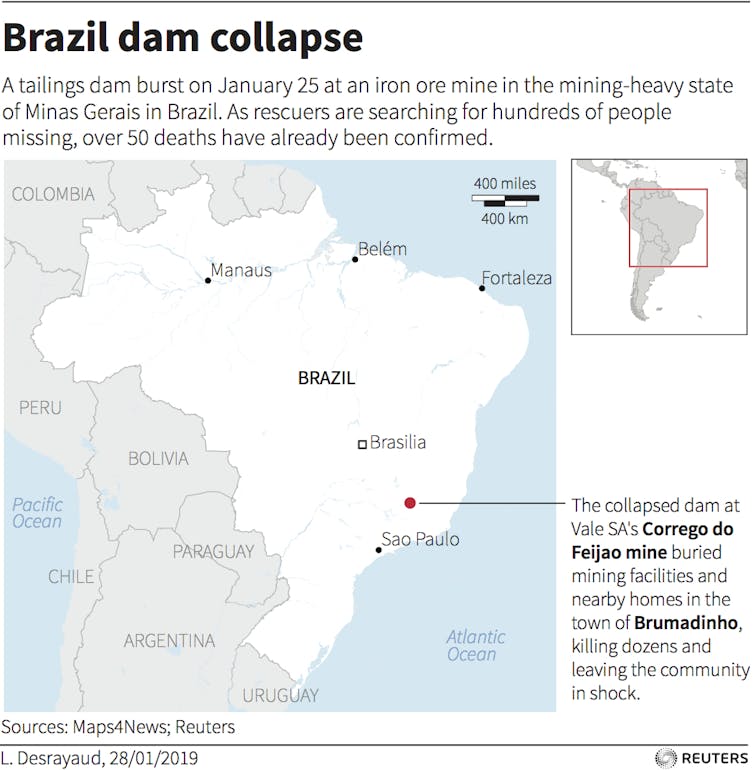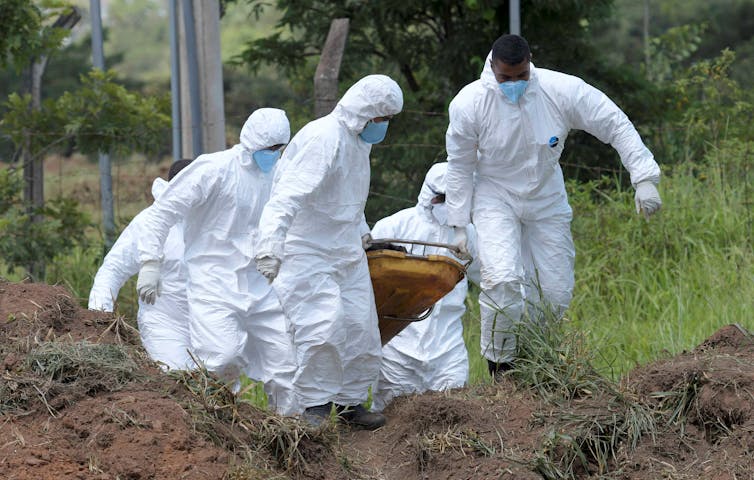Dam collapse at Brazilian mine exposes grave safety problems
- Written by Julian D. Olden, Professor of Aquatic and Fishery Sciences, University of Washington
Brazilian rescue workers continue searching[1] for more than 300 people missing after a dam burst at an iron ore mine over the weekend.
The dam, which ruptured on Jan. 25 close to the Brazilian town of Brumadinho, Minas Gerais state, released a muddy sludge of watery mine waste that engulfed buildings, vehicles and roads. At least 65 people are confirmed dead[2], and the official toll will rise as the missing are declared dead.
The catastrophe has exposed the dangers of Brazil’s aging dam system. A recent government report[3] found nearly 1,800 dams in Brazil at high or moderate risk of failure. The figure is all the more stunning because the report’s authors evaluated just one-fifth of Brazil’s nearly 24,000 registered dams.
Brazil’s unsafe dams
Dams are an environmentally and economically risky business, as our global research on hydropower[4] and many other studies[5] have shown.
Beyond the loss of human life, the economic damages of a dam breach can soar into the billions[6]. An entire region’s natural and cultural heritage may be decimated by flooding, and the freshwater ecosystems[7] that humans and fish alike rely on compromised.
Yet dozens of countries worldwide, including the United States and Canada, use dams to store water, generate electricity and trap mine waste, or “tailings.” And there’s no easy or cheap way to dismantle or fix aging dams.
The Brumadinho dam collapse is the second dam accident in Brazil involving one of the world’s largest iron ore producers, Vale S.A.[8], in recent years.
In November 2015, two of Vale S.A.‘s tailings dams – that is, dams used to contain the watery runoff of nearby mines – also collapsed in Minas Gerais state, where some mountains are made almost entirely of iron ore.
That disaster killed 19 people and spewed over 10 billion gallons of water and mine sediment downstream, contaminating 441 miles of Brazil’s Rio Doce river before reaching the Atlantic Ocean. It is considered the country’s worst environmental tragedy ever[9].
 Reuters[10]
Repairing broken dams in Brazil can cost between US$40,000 and $10 million per dam[11], according to Brazil’s national water authority. That is a financial hurdle for a country that has been in deep recession since 2015.
But the social, economic and environmental costs of letting old dams fail may be higher.
Reducing the risk of dam failure
The environmental damage is particularly acute when tailings dams collapse, since the large amounts of mining waste they release is highly toxic.
Of the roughly 3,500 tailings dams worldwide, over 300 collapse each year. Two to five of those are “major” failures like Brazil’s[12].
Prompted by this impending danger, the United Nations Environmental Program recently issued recommendations[13] for enhancing tailings dam safety around the world.
Mining companies should strive for zero-failure, it said, warning that “safety attributes should be evaluated separately from economic considerations, and cost should not be the determining factor.”
The report also suggests the creation of a global database of mine sites and tailings storage facilities to better track, and ultimately predict, dam failures.
When old dams have become too costly to maintain or repair, removal is generally considered the best course. Dismantling old dams, as the United States[14] and Europe[15] are increasingly doing, also restores freshwater ecosystems that have been impacted by decades of damming.
Brazil is considering decommissioning at least one dam[16], in the country’s north, due to biodiversity concerns and because it no longer efficiently produces hydroelectricity.
Since the country has federal guidelines regulating the treatment of old dams, the decision about whether to repair, dismantle or continue operating dams is largely left to state officials. Brazilian president Jair Bolsonaro has promised to further deregulate the mining industry[17].
That setup, we fear, leaves the country ill-equipped to deal with its impending dam crisis.
Reuters[10]
Repairing broken dams in Brazil can cost between US$40,000 and $10 million per dam[11], according to Brazil’s national water authority. That is a financial hurdle for a country that has been in deep recession since 2015.
But the social, economic and environmental costs of letting old dams fail may be higher.
Reducing the risk of dam failure
The environmental damage is particularly acute when tailings dams collapse, since the large amounts of mining waste they release is highly toxic.
Of the roughly 3,500 tailings dams worldwide, over 300 collapse each year. Two to five of those are “major” failures like Brazil’s[12].
Prompted by this impending danger, the United Nations Environmental Program recently issued recommendations[13] for enhancing tailings dam safety around the world.
Mining companies should strive for zero-failure, it said, warning that “safety attributes should be evaluated separately from economic considerations, and cost should not be the determining factor.”
The report also suggests the creation of a global database of mine sites and tailings storage facilities to better track, and ultimately predict, dam failures.
When old dams have become too costly to maintain or repair, removal is generally considered the best course. Dismantling old dams, as the United States[14] and Europe[15] are increasingly doing, also restores freshwater ecosystems that have been impacted by decades of damming.
Brazil is considering decommissioning at least one dam[16], in the country’s north, due to biodiversity concerns and because it no longer efficiently produces hydroelectricity.
Since the country has federal guidelines regulating the treatment of old dams, the decision about whether to repair, dismantle or continue operating dams is largely left to state officials. Brazilian president Jair Bolsonaro has promised to further deregulate the mining industry[17].
That setup, we fear, leaves the country ill-equipped to deal with its impending dam crisis.
 Rescue workers at Brazil’s Brumadinho dam collapse in protective gear. The sludge released in the disaster contained iron ore mine waste.
Reuters/Washington Alves[18]
Technological improvements
To increase the safety of its mines, Brazil and other countries could look beyond dams for storing iron ore waste.
New technology has created some promising alternative solutions[19].
These include approaches that create a paste of thickened mine tailings, which may then be stored either above ground or in impermeable plastic sheathes below the surface. This method both makes it less likely that the contamination seeps into the ground. It also reduces water use. However, it is expensive.
Constructed and engineered wetlands can also act as treatment systems – a kind of faux natural filter.
Wetlands are affordable to build and operate and require relatively little maintenance. Technology can enhance[20] their natural capacity to remove contamination from wastewater.
However, mines must have sufficient available land to support wetlands, and the these systems – like all wetlands – don’t work as efficiently during cold winter months.
Every mine is uniquely situated in terms of its geography, physical setting, environmental context and human population. None of these waste-storage systems alone will make tailings dams obsolete.
But Brazil’s Brumadinho dam collapse is the world’s latest reminder of the risk posed by old and unsafe dams. With national safety guidelines informed by science and stricter enforcement, countries can reduce the chance of a disaster like this happening again.
Rescue workers at Brazil’s Brumadinho dam collapse in protective gear. The sludge released in the disaster contained iron ore mine waste.
Reuters/Washington Alves[18]
Technological improvements
To increase the safety of its mines, Brazil and other countries could look beyond dams for storing iron ore waste.
New technology has created some promising alternative solutions[19].
These include approaches that create a paste of thickened mine tailings, which may then be stored either above ground or in impermeable plastic sheathes below the surface. This method both makes it less likely that the contamination seeps into the ground. It also reduces water use. However, it is expensive.
Constructed and engineered wetlands can also act as treatment systems – a kind of faux natural filter.
Wetlands are affordable to build and operate and require relatively little maintenance. Technology can enhance[20] their natural capacity to remove contamination from wastewater.
However, mines must have sufficient available land to support wetlands, and the these systems – like all wetlands – don’t work as efficiently during cold winter months.
Every mine is uniquely situated in terms of its geography, physical setting, environmental context and human population. None of these waste-storage systems alone will make tailings dams obsolete.
But Brazil’s Brumadinho dam collapse is the world’s latest reminder of the risk posed by old and unsafe dams. With national safety guidelines informed by science and stricter enforcement, countries can reduce the chance of a disaster like this happening again.
References
- ^ continue searching (www.npr.org)
- ^ confirmed dead (www.nytimes.com)
- ^ government report (www3.ana.gov.br)
- ^ global research on hydropower (www.washington.edu)
- ^ other studies (www.sciencemag.org)
- ^ soar into the billions (www.latimes.com)
- ^ freshwater ecosystems (theconversation.com)
- ^ Vale S.A. (www.ft.com)
- ^ worst environmental tragedy ever (www.sciencedirect.com)
- ^ Reuters (pictures.reuters.com)
- ^ per dam (www3.ana.gov.br)
- ^ “major” failures like Brazil’s (www.sciencedirect.com)
- ^ the United Nations Environmental Program recently issued recommendations (www.grida.no)
- ^ United States (science.sciencemag.org)
- ^ Europe (www.nature.com)
- ^ considering decommissioning at least one dam (onorte.net)
- ^ deregulate the mining industry (www.theguardian.com)
- ^ Reuters/Washington Alves (pictures.reuters.com)
- ^ alternative solutions (www.sciencedirect.com)
- ^ enhance (www.sciencedirect.com)
Authors: Julian D. Olden, Professor of Aquatic and Fishery Sciences, University of Washington
Read more http://theconversation.com/dam-collapse-at-brazilian-mine-exposes-grave-safety-problems-110666

